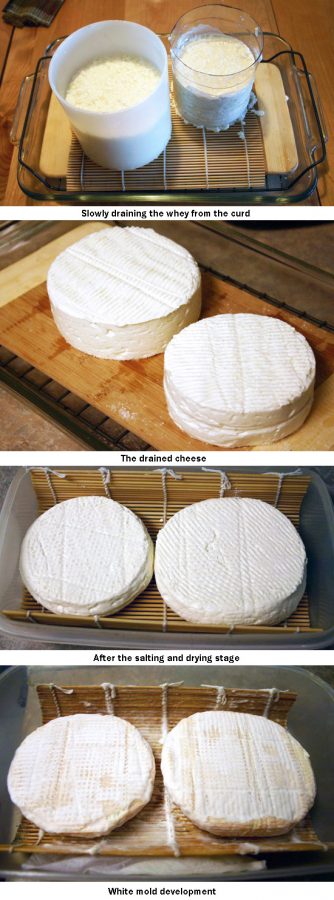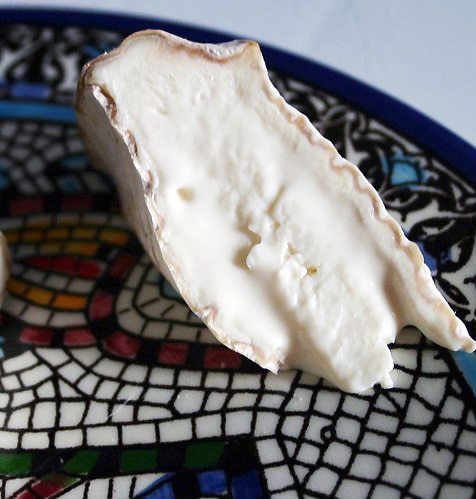This is the 9th month of the worldwind Cheesepalooza challenge and only 2 more months to go after. I have to say I have learned so much since I began this cheese adventure. I have learned to try and be as precise as possible (I am bad at it), I have learned patience, I learned to not throw in the towel after failures, and I learned to make cheese at home.
April was a new and scary month were we played with mold on pupose! This month we were asked to make a Brie or Camembert, I opted for the later because I like the slightly tangier taste that Camembert. Making the cheese is similar to past experiences but how do you get that lovely white mold to grow?
The magic of the white mold is actually caused by the Penicillium candidum bacteria. In this recipe it is added right to the cheese making recipe and with time the bacteria works it’s way to the surface, changing the aroma and texture in a protective crust. In my case I did not get a complete coverage as some spots stayed bare. But the crust still formed.
So here is a very important lesson to learn from making a white mold cheese. Eat it young. In 3 weeks it is ready and don’t wait too much longer. I forgot and waited 4 weeks. The inside of the cheese was very runny and the taste was very pungent. I probably did not do something right along the way because a cheese that runny is not normal. I did not mind the intense flavor so I still ate it. The second cheese I partly froze so I could cut it and take decent pictures. I think the cheese had not dried out enough before I started aging it, there wass till too much moisture in the curd.
This recipe makes 4 cheeses but I made half of it so got 2 cheeses.

Cheesepalooza: Camembert
Ingredients
- 1 gallon whole milk
- 1/4 tsp calcium chloride dissolved in 1/4 c. water
- 2 oz mesophilic culture cubes or 1/4 tsp direct set
- 1/4 tsp liquid rennet dissolved in 1/4 c. water
- 1/8 tsp Penicillium Candidum
- 4 tsp canning salt
Instructions
- Add milk to a large pot. Thoroughly stir in the dissolved calcium chloride. Heat the milk to 85F degrees, stirring.
- Add the mesophilic culture and stir until melted or dissolved. Cover the pot and allow to sit and ripen for 30 minutes.
- Add the dissolved rennet, stirring for one minute in a gentle up & down motion. Cover the pot and allow to sit forming curds for 90 minutes, maintaining the temperature at 85F.
- Test for a clean break by using a knife to just lift a bit of the curd. It should lift clean and smooth and the void should fill with a bit of whey.
- Cut the curds to 1 inch cubes. Allow to sit and heal for 5 minutes.
- Stir the curds gently in a lifting from the bottom motion with a skimmer for 5 to 10 minutes or until the curds shrink up a bit. Let the curds settle.
- With a measuring cup, pour off and scoop out as much whey as possible.
- Gently spoon curds into 4 Camembert molds set on a draining mat atop a rack in a big dish or pan. Let drain for 2 hours. Gently turn over the molds by sandwiching them between mats and boards. Allow to drain for another 2 of hours, then turn the molds again. Drain whey out of pan, place cheeses back, cover and let drain at room temperature overnight. Flip in the morning and leave for another 2 hours.
- Remove the molds and sprinkle each side of the rounds of cheese with 1/2 tsp of salt.
- Place cheeses on a cheese mat in a box with the lid. Ripen at 50F and 90% humidity. Flip cheeses daily and remove any whey.
- After a few days to a week, the mold will start to grow. It starts as spots of fuzzy white spores and grows to cover the entire surface. Turn daily and pat down the fuzz gently.
- At around 12 days when the cheese is all covered, wrap in cheese-ripening paper and age for 3 to 4 weeks.







Camembert is a very popular and common cheese we can get in Japan and my grandpa used to love eating it. I kind of wished that I could make it from scratch for him. He’d be really thrilled to see homemade version! Yours look wonderful. I’ve been very impressed with your culinary adventure.
WOW!!! I am SO, SO impressed!! I would never, ever think that brie or camembert could be made at home, but yours looks picture perfect. You rocked this challenge, my friend!!!
Wow, this is incredible! I only make ricotta at home, but making Camembert is fabulous. It should be such a satisfactory feeling having a cheese platter with a cheese you’ve made yourself!
My husband loves Camembert cheese and you made two perfect heads as we call them in Greece!
I tip my hat to you, your cheese are amazing and I dream of making them as well as you do Eve! 😀
What beautiful rind and I’m especially in love with that creamy, soft center!!
Wow Evelyne, I’m in total awe!! They look perfect! I never knew we could make camembert at home. You’re so brave! You encouraged me to give this a try someday soon 🙂
You are AMAZING,Eve.
I think my ex really liked this particular type of cheese. Not sure why.